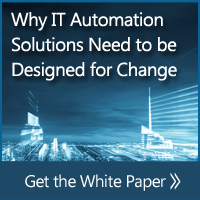Oracle OpenWorld: End-to-End IT Process Automation
Oracle OpenWorld presents the opportunity to speak with attendees about using job scheduling and Workload Automation to automate Oracle technologies.


Over the years, Oracle has added a wide array, either through acquisition or internal development, of applications, middleware solutions and data sources. While this offers IT organizations with a “one stop shop,” it’s also resulted in a heterogeneous collection of newer cloud-based solutions and older, legacy applications that IT operational and business processes must span. For developers looking to automate these processes, each of these solutions can represent “silos of automation” that erect barriers to automating such processes.
As a result, it’s not surprising that a common theme among attendees we talked to at Oracle OpenWorld 2013 has been the limitations inherent to using platform-specific scheduling tools. For example, tools such as Concurrent Manager and Process Scheduler for Oracle E-Business Suite (EBS) and PeopleSoft or PL/SQL scripts to schedule Oracle database processes makes it difficult to automate and manage cross-application and cross-departmental processes that solutions such as these are dependent on. The result is a lot of custom scripting, which is time consuming and expensive. The idea is to take an “architectural” approach to IT automation using an enterprise job scheduling solution to allow Oracle developers and DBAs to automate these processes and integrate these solutions with both Oracle and non-Oracle technologies to improve productivity and add speed and agility to an IT organization. Here are some of the key topics that have resonated with Oracle attendees at this year’s show:
- Like most enterprise applications, Oracle EBS, PeopleSoft and JDEdwards have their own native schedulers that are limited to scheduling their respective applications. Oracle attendees, operating in a mixed environment of heterogeneous applications and platforms (we heard developers looking to integrate Oracle systems with offerings from Microsoft, SAP, IBM, mainframe and/or distributed platforms) are looking to more easily pass data and manage dependencies. The idea of an enterprise job scheduling solution as a “single point of control” to more easily build and manage these cross-application and cross-platform batch processes can save Oracle developers time and money.
- Outside of the mainstream offerings from vendors, attendees wanted to the ability to schedule their scripts and custom-built applications from within a single framework. The ability of a job scheduler to be script language independent and support technologies including Java, Web Services and Oracle Stored Procedures to allow it to “hook” into third-party applications provides an “extensible scheduling platform,” as one attendee put it. Today, batch processes can span everything from legacy applications to newer, standards-based systems built upon SOA or Web Services. The ability to integrate the “old with the new” within end-to-end workflows is critical.
- This level of “extensibility” also dovetails another point: adopting a single automation solution from which to automate and manage IT operational and business processes means adopting a solution that is built for change. As IT organizations are forced to adapt due to changing IT environments and business requirements, having a single automation solution that is built for change adds agility to an IT organization by simplifying the building and modification of complex workflows and process types. This certainly applies to operating within heterogeneous environments that contain a mix of both Oracle and non-Oracle applications and platforms. Being able to quickly and efficiently update workflows that have been centralized within an enterprise automation solution simplifies IT’s job of supporting the business.
- Scheduling Oracle database processes and administrative-type processes, such as file system and database table cleanups, across multiple databases is an otherwise time consuming and tedious process when handled individually. Oracle DBAs valued the concept of using an enterprise automation solution to allow them to schedule a PL/SQL, Export or Import task once, but execute it multiple times across different Oracle DBs within a single interface.








